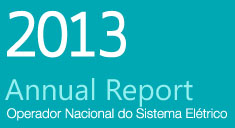Highlights of 2013
-
1.Pre-operational studies of the Madeira River Complex
For the entry into operation of the transmission system associated with the Madeira River Complex, ONS coordinated a working group of the presidents of the agents involved, in order to facilitate the solution of the problems that had to be faced. Also, ONS designed and implemented control measures and systemic protection that allowed to overcome the limitations for the flow of the units production available in Santo Antônio and Jirau, and allowed the operation of the first bipole DC substations between Porto Velho, Rondônia, and Araraquara, São Paulo. -
2.Interconnection Tucuruí – Manaus – Macapá
In July 2013, the Amazon was integrated into the Brazilian Interconnected Power System (BIPS) through a transmission system at 500 kV, with approximately 1,400 km long. Delays in the installation of the receptor systems in Manaus and Macapa demanded from ONS the definition of operational measures that would mitigate the risk of load shedding as both to Manaus and to Macapa, in an eventual loss of interconnection. It was also necessary to define a Regional Load Alleviation Scheme (Erac) and establish the thermal generation to be maintained during this initial operation, to reduce the impacts of contingencies in the system. -
3.Performance of the Technical Teams on Optimization of Electro Power Availabilities of the BIPS during the Wet Season 2012-2013
The delay on the characterization of the wet season 2012-2013 in the Southeast / Midwest, Northeast and North, in sequence to a pronounced dry season in the Northeast and South, with low inflows and depletion of reserves accumulated in the reservoirs of the BIPS, led CMSE to authorize the dispatch of the full thermoelectric plants from mid-October, including nuclear power plants, coal, gas and liquid fuels. This situation required the operational planning and daily and weekly scheduling technical teams a careful management of existing reserves and careful management of the transmission grid in order to facilitate transfers of additional power through the main trunks of interconnection between areas and regions. -
4.Gestão das Disponibilidades Eletroenegéticas do BIPS
The delayed beginning of the wet season in the SE/CO and NE regions and hydrological conditions prevailing throughout the year demanded from ONS careful management of available energy in order to preserve the stocks of energy stored in the reservoirs and at the same time, reduce the impact on the operating costs of the full order of the thermoelectric power. Studies by the operator were the basis for decision making by the Monitoring Committee of the Electrical Sector (CMSE), allowing to remove from the operation the thermal liquid fuel higher cost plants between May and August. From September, the thermal dispatch started being performed according to the methodology Conditioning Value Risk (CVaR), deployed in the optimization models. -
5.Belo Monte Transmission System
In 2013, ONS developed various activities related to the integration of the transmission system of the Belo Monte power plant to BIPS, highlighting the technical and economic analysis of alternatives, the detailing of the recommended alternative, the engineering studies associated with alternative reference and the preparation of the Technical Annex of the bidding, submitted to ANEEL in October. -
6. Introduction CVaR Models in the Energy Optimization
From the Monthly Program Operation (PMO) in September 2013, due to the 03/2013 Resolution of the National Energy Policy Council (CNPE), ONS began using the mechanism called Value Conditioning Risk (CVaR), to avoid the order of thermal plants outside the order of economic merit. Designed in partnership with the GeorgiaTech University and implemented by the Center for Electrical Energy Research (Cepel) in Newave and Decomp models, CVaR underwent a thorough evaluation by the Standing Committee for Analysis of Computational Methods and Programs for the Electric Sector (CPAMP) and a validation process involving all agents, before having its use authorized by Aneel.
The CVaR can be understood as the calculation of the average future cost of operation, used to define the thermal dispatch, with an altered influx of scenarios, in which the most unfavorable are given more weight. -
7.Differentiated Operation in Major Events
In the two major international events of the year - the FIFA Confederations Cup and 2013 World Youth Journey - ONS held preparatory actions involving their own teams and all agents operating in the areas of interest of host cities in order to provide additional level of security to the electrical operation of BIPS. These actions were successfully implemented, ensuring continuity and quality of service to consumers and to society. -
8.Recognition by ABRH of People Management at NOS
The development achieved by ONS in the management of people was recognized by the Brazilian Association of Human Resources (ABRH), to grant him the 33rd Human Being Award in 2013, one of the most important awards of the area. ONS was one of the winners in medium / large company category, with the case study "Knowledge Management: a practice that generates organizational learning." It was also a finalist in the case study "Project Mentoring".
